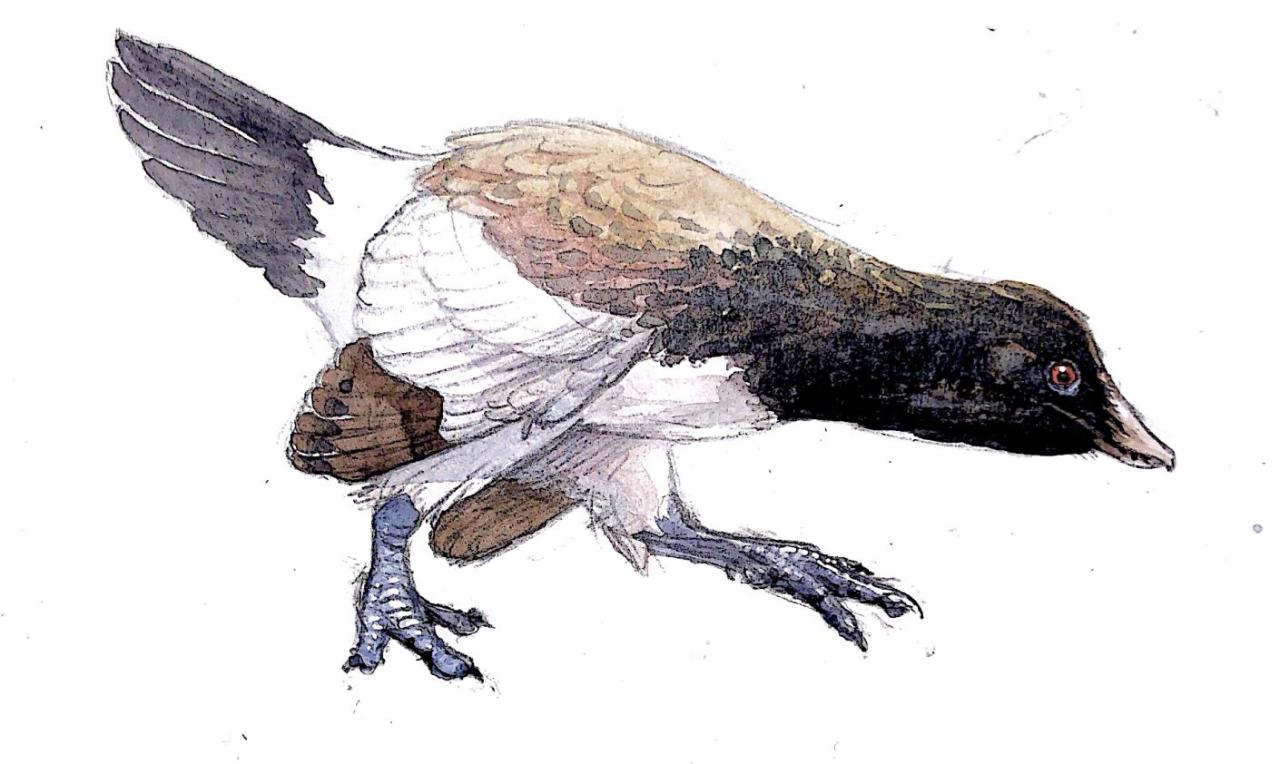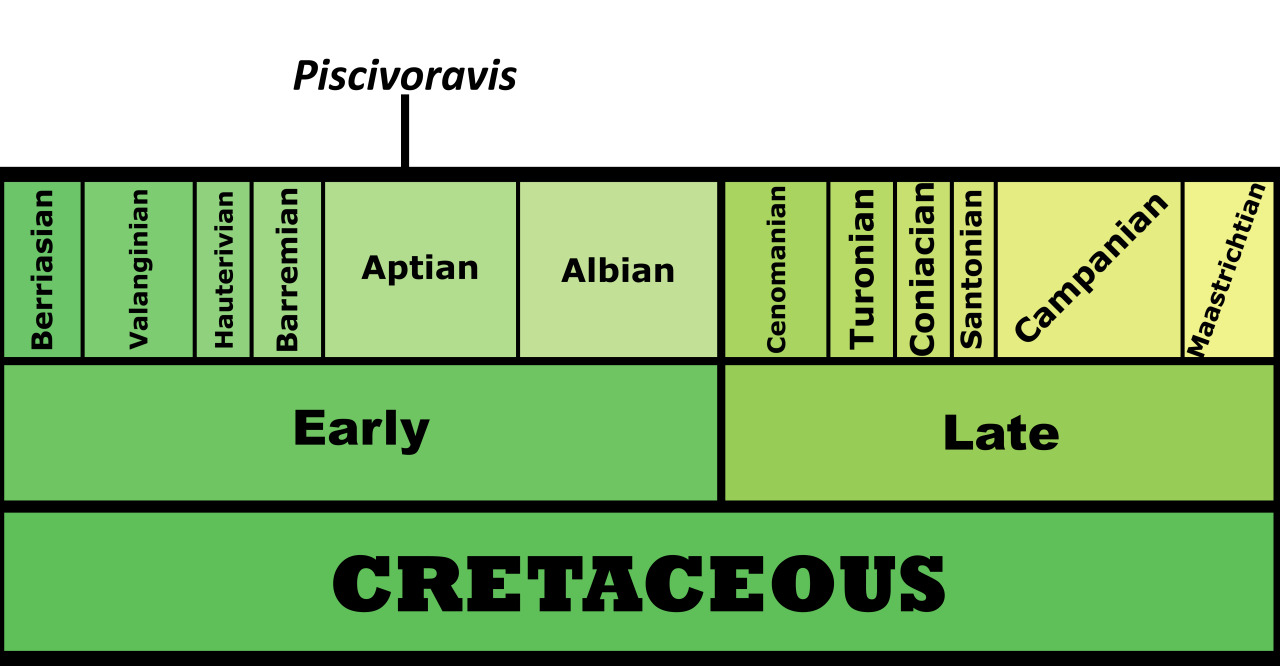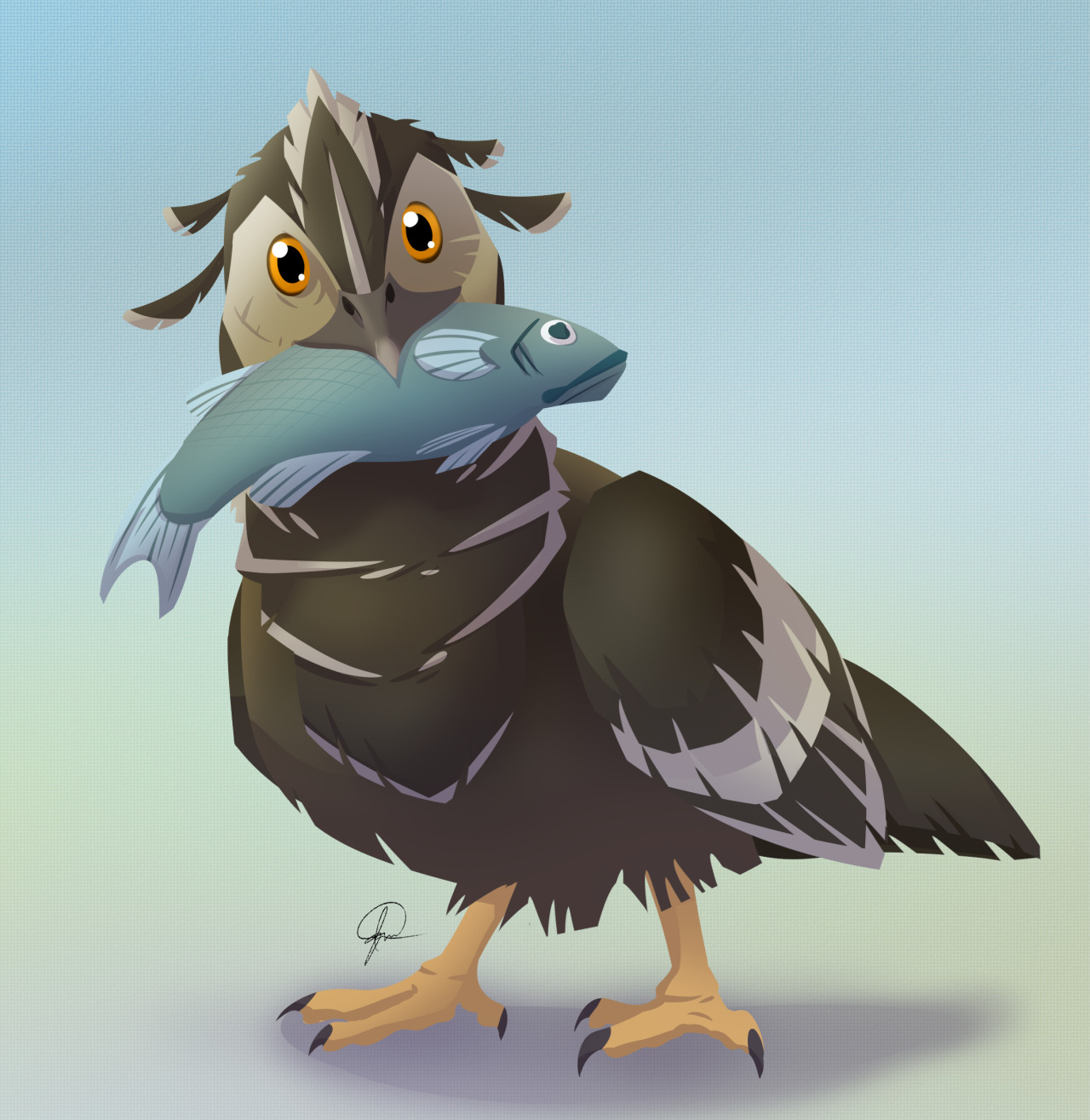
By Ripley Cook
Etymology: Fish Eating Bird
First Described By: 2013
Classification: Dinosauromorpha, Dinosauriformes, Dracohors, Dinosauria, Saurischia, Eusaurischia, Theropoda, Neotheropoda, Averostra, Tetanurae, Orionides, Avetheropoda, Coelurosauria, Tyrannoraptora, Maniraptoriformes, Maniraptora, Pennaraptora, Paraves, Eumaniraptora, Averaptora, Avialae, Euavialae, Avebrevicauda, Pygostylia, Ornithothoraces, Euornithes, Ornithuromorpha, Songlingornithidae
Status: Extinct
Time and Place: 120 million years ago, in the Aptian age of the Early Cretaceous


Piscivoravis is known from the Shangheshou Beds of the Jiufotang Formation in Liaoning, China

Physical Description: Piscivoravis was a fairly large proto-bird, growing between 30 and 35 centimeters long. It had a strong wishbone, which would have allowed for extensive chest muscles, giving it better flight ability than most of its relatives at the time. It had large claws and digits on its feet and hands which would have been very noticeable in the wings – it’s possible it may have used those claws to cling to branches and tree trunks. Piscivoravis was preserved with feathers, which show that it had an alula. Alulas are a group of three to six small, stiff feathers growing off of the first digit in modern birds – not preserved often in Mesozoic birds, scientists have limited themselves to looking for the specialized structure in the first finger that would indicate their presence. However, Piscivoravis doesn’t have that structure – indicating the alula feathers evolved before the structure did. It also had a full fan of tail feathers – a distinctive trait of the birdie dinosaurs that would become birds proper. The feathers were broad and rounded to form a single aerodynamic surface, which would have helped it to fly.
Diet: Piscivoravis was found with fish preserved in its digestive tract, making it one of the few confirmed piscivorous Mesozoic birds.
Behavior: Piscivoravis would spend a lot of its time around the lakes of its environment, grabbing fish out of the water – a unique niche for it that would have helped it to avoid competition with other animals in its very diverse environment. It would have swallowed the food and separated it into digestible parts and non-digestible parts, and formed the latter into a pellet – much like modern hawks and owls do. This was preserved in its stomach, and it would then vomit up the pellet to save energy trying (and failing) to digest it.

By Scott Reid
As a strong flier, it’s possible that Piscivoravis would source over the lakes like some shorebirds today, looking for traces of fish and other aquatic sources of food under the surface. We don’t know how well it could see, however, to test if it would be able to spot such prey. It’s possible – since this was a system of lakes surrounded by forest – that Piscivoravis may have peered down at the lakes from trees (held onto with strong claws), then used their strong flight to fly down quickly towards the sources of food.
As a dinosaur, Piscivoravis most likely took care of its young, though it’s difficult to know either way without more fossils. It is uncertain whether or not it would have lived in groups – either possibility, solitary or social life, seems possible.
Ecosystem: Piscivoravis lived in the Jiufotang Formation, the later of the Jehol Biota formations that showcase the initial evolution of a lot of modern groups – especially birds, placental mammals, and flowers. It was a system of lakes, surrounded by a temperate forest. Active volcanoes nearby would explode on occasion, leading to rapid covering and then preservation of the life in the forest. The earlier Yixian Formation is somewhat better known and more diverse than the Jiufotang, but there was still a lot of fascinating creatures in the Jiufotang. Piscivoravis is known from the Shangheshou Bed, aka the second and third members of the formation, where a lot of the more famous animals of the environment are found. The environment was probably still heavily forested, mostly populated with coniferous trees and ferns, but with some burgeoning flowers as well. There was a variety of frogs and fish for Piscivoravis to feed on, though most of the named ones come from other parts of the formation.
Mammals were present in the formation – notably Lactodens and Liaconodon. The oddball, crocodile-esque Choristoderes were represented by Philydrosaurus and Ikechosaurus. Turtles include Perochelys and Liaochelys. There was the famed Jiufotang Lizard Yabeinosaurus as well. There were a lot of pterosaurs, including Sinopterus, Linlongopterus, Liaoxipterus, Chaoyangopterus, Longchengpterus, Eoazhdarcho, Huaxiapterus, Hongshanopterus, Jidapterus, and Shenzhoupterus. And this was just the non-dinosaurs.

By José Carlos Cortés
Dinosaurs included – well, there were a lot of them. The only Ornithischian known from this member was Psittacosaurus. There were a few non-Avialan theropods, too, such as Sinotyrannus, Microraptor and Similcaudipteryx. Still, the fast majority of dinosaurs present were birdie dinosaurs, which I’m just going to list now: Longipteryx, Confuciusornis, Omnivoropteryx, Sapeornis, Sinornis, Yixianornis, Bohaiornis, Parabohaiornis, Longusunguis, Juehuaornis, Parapengornis, Fortunguavis, Cathayornis, Largirostrornis, Yanornis, Gracilornis, Eocathayornis, Jeholornis, Schizooura, Zhongjianornis, Jianchangornis, Archaeorhynchus, Songlingornis, Chaoyangia, Longchengornis, Boluochia, Houornis, Xiangornis, Huoshanornis, Pengornis, Dapingfangornis, Piscivorenantiornis, Parahongshanornis, Alethoalaornis, Yuanjiawaornis, and Bellulornis. Feel free to dig through the ADAD blog to find out about all of these. Piscivoravis probably would have feared Sinotyrannus the most out of all these members of its environment, in terms of what would eat it.
Other: Piscivoravis was a Songlingornithid, a group of early very-near-birds found in the Aptian age of China. Many other kinds coexisted with Piscivoravis, and surprisingly, a lot of the group of birdie dinosaurs that became birds (the Euornithes) had at least somewhat aquatic lifestyles. So, full beaks in modern birds evolved in water-based environments, though we’re not entirely sure why.
~ By Meig Dickson
Sources
Czerkas, S. A., D. Zhang, J. Li and Y. Li. 2002. Flying dromaeosaurs. In S. J. Czerkas (ed.), Feathered Dinosaurs and the Origin of Flight. The Dinosaur Museum Journal 1. The Dinosaur Museum, Blanding, UT 96-126
Czerkas, S. A., and Q. Ji. 2002. A preliminary report on an omnivorous volant bird from northeast China. In S. J. Czerkas (ed.), Feathered Dinosaurs and the Origin of Flight. The Dinosaur Museum Journal 1. The Dinosaur Museum, Blanding, UT 127-135
Dong, Z.-M., Y.-W. Sun, and S.-Y. Wu. 2003. On a new pterosaur from the Lower Cretaceous of Chaoyang Basin, Western Liaoning, China. Global Geology 22:1-7
Dong, Z., and J. Lü. 2005. A new ctenochasmatid pterosaur from the Early Cretaceous of Liaoning Province. Acta Geologica Sinica 79(2):164-167
Dong, L., Y. Wang, and S. E. Evans. 2017. A new lizard (Reptilia: Squamata) from the Lower Cretaceous Yixian Formation of China, with a taxonomic revision of Yabeinosaurus. Cretaceous Research
Evans, S. E., and Y. Wang. 2011. A gravid lizard from the Cretaceous of China and the early history of squamate viviparity. Naturwissenschaften 98:739-743
Evans, S. E., and Y. Wang. 2012. New material of the Early Cretaceous lizard Yabeinosaurus from China. Cretaceous Research 34:48-60
Gao, K.-Q., and R. C. Fox. 2005. A new choristodere (Reptilia: Diapsida) from the Lower Cretaceous of western Liaoning Province, CHina, and phylogenetic relationships of Monjurosuchidae. Zoological Journal of the Linnean Society of London 145:427-444
Gao, K.-Q., D. T. Ksepka, L. Hou, Y. Duan, and D. Hu. 2007. Cranial morphology of an Early Cretaceous monjurosuchid (Reptilia: Diapsida) from Liaoning Province of China and evolution of the choristoderan palate. Historical Biology 19(3):215-224
Han, G., and J. Meng. 2016. A new spalacolestine mammal from the Early Cretaceous Jehol Biota and implications for the morphology, phylogeny, and palaeobiology of Laurasian ‘symmetrodontans’. Zoological Journal of the Linnean Society 178:343-380
Hou, L., and J. Zhang. 1993. [A new fossil bird from Lower Cretaceous of Liaoning]. Vertebrata PalAsiatica 31(3):217-224
Hou, L. H. 1997. Mesozoic Birds of China.
Hu, D., L. Li, L. Hou and X. Xing. 2010. A new sapeornithid bird from China and its implication for early avian evolution. Acta Geologica Sinica 84(3):472-482
Hu, D.-Y., X. Xu, L. Hou and C. Sullivan. 2012. A new enantiornithine bird from the Lower Cretaceous of Western Liaoning, China, and its implications for early avian evolution. Journal of Vertebrate Paleontology 32(3):639-645
Hu, D., Y. Liu, J. Li, X. Xu, and L. Hou. 2015. Yuanjiawaornis viriosus, gen. et sp. nov., a large enantiornithine bird from the Lower Cretaceous of western Liaoning, China. Cretaceous Research 55:210-219
Hu, H., J. K. O’Connor, and Z. Zhou. 2015. A new species of Pengornithidae (Aves: Enantiornithes) from the Lower Cretaceous of China suggests a specialized scansorial habitat previously unknown in early birds. Plos One 10(6):e0126791
Ji, Q., S.-a. Ji, and L.-j. Zhang. 2009. First large tyrannosauroid theropod from the Early Cretaceous Jehol Biota in northeastern China. Geological Bulletin of China 28(10):1369-1374
Evans, Q., and Y. Wang. 2011. A gravid lizard from the Cretaceous of China and the early history of squamate viviparity. Naturwissenschaften 98:739-743
Li, J.-J., J.-C. Lü, and B.-K. Zhang. 2003. A new Lower Cretaceous sinopteroid pterosaur from western Liaoning, China. Acta Palaeontologica Sinica 42(3):442-447
Li, L., Y. Duan, D. Hu, L. Wang, S. Cheng and L. Hou. 2006. New Eoenantiornithid Bird from the Early Cretaceous Jiufotang Formation of Western Liaoning, China. Acta Geologica Sinica (English Edition) 80(1):38-41
Li, Z., Z. Zhou, M. Wang and J. A. Clarke. 2014. A new specimen of large-bodied basal enantiornithine Bohaiornis from the Early Cretaceous of China and the inference of feeding ecology in Mesozoic birds. Journal of Paleontology 88(1):99-108
Li, L., D.-y. Hu, Y. Duan, E=p Gong, and L.-h. Hou. 2007. Alethoalaornithidae fam. nov.: a new family of enantiornithine bird from the Lower Cretaceous of western Liaoning. Acta Palaeontologica Sinica 46(3):365-372
Li, L., J.-Q. Wang, and S.-L. Hou. 2011. A new ornithurine bird (Hongshanornithidae) from the Jiufotang Formation of Chaoyang, Liaoning, China. Vertebrata PalAsiatica 49(2):195-200
Li, L., W. G. Joyce, and J. Liu. 2015. The first soft-shelled turtle from the Jehol Biota of China. Journal of Vertebrate Paleontology 35(2):e909450
Liu, J. 2004. A nearly complete skeleton of Ikechosaurus pijiagouensis sp. nov. (Reptilia: Choristodera) from the Jiufotang Formation (Lower Cretaceous) of Liaoning, China. Vertebrata PalAsiatica 42(2):120-129
Lü, J., and C. Yuan. 2005. New tapejarid pterosaur from western Liaoning, China. Acta Geologica Sinica 79(4):453-458
Lü, J., and Q. Ji. 2005. New azhdarchid pterosaur from the Early Cretaceous of western Liaoning. Acta Geologica Sinica 79(3):301-307
Lü, J., X. Jin, D. M. Unwin, L. Zhao, Y. Azuma and Q. Ji. 2006. A new species of Huaxiapterus (Pterosauria: Pterodactyloidea) from the Lower Cretaceous of western Liaoning, China with comments on the systematics of tapejarid pterosaurs. Acta Geologica Sinica 80(3):315-326
Lü, J., J. Liu, C. Gao, Q. Meng, and Q. Ji. 2006. New material of pterosaur Sinopterus (Reptilia: Pterosauria) from the Early Cretaceous Jiufotang Formation, Western Liaoning, China. Acta Geologica Sinica 80(6):783-789
Lü, J., D. M. Unwin, L. Xu and X. Zhang. 2008. A new azhdarchoid pterosaur from the Lower Cretaceous of China and its implications for pterosaur phylogeny and evolution. Naturwissenschften 95:891-897
Martyniuk, M. P. 2012. A Field Guide to Mesozoic Birds and other Winged Dinosaurs. Pan Aves; Vernon, New Jersey.
Meng, J., Y. Wang, and C. Li. 2011. Transitional mammalian middle ear from a new Cretaceous Jehol eutriconodont. Nature 472:181-185
Norell, M. A., Q. Ji, C. Yuan, Y. Zhao, and L. Wang. 2002. ‘Modern’ feathers on a non-avian dinosaur. Nature 416:36-37
O’Connor, J. K.; Zhang, Y.; Chiappe, L. M.; Meng, Q.; Quanguo, L.; Di, L. 2013. A new enantiornithine from the Yixian Formation with the first recognized avian enamel specialization. Journal of Vertebrate Paleontology. 33(1): 1 – 12.
O’Connor, J. K., C. Sun, X. Xu, X. Wang, and Z. Zhou. 2012. A new species of Jeholornis with complete caudal integument. Historical Biology 24(1):29-41
Provini, P., Z.-H. Zhou, and F.-C. Zhang. 2009. A new species of the basal bird Sapeornis from the Early Cretaceous of Liaoning, China. Vertebrata PalAsiatica 47(3):194-207
Rodrigues, T., S. Jiang, X. Cheng, X. Wang, and A. W. A. Kellner. 2015. A new toothed pteranodontoid (Pterosauria, Pterodactyloidea) from the Jiufotang Formation (Lower Cretaceous, Aptian) of China and comments on Liaoningopterus gui Wang and Zhou, 2003. Historical Biology 27(6):782-795
Wang, M., J. K. O’Connor, Z. Zhou. 2014. A new robust enantiornithine bird from the lower Cretaceous of China with scansorial adaptations. Journal of Vertebrate Paleontology.
Wang, M., and Z. Zhou. 2017. A morphological study of the first known piscivorous enantiornithine bird from the Early Cretaceous of China. Journal of Vertebrate Paleontology 37(2):e1278702:1-13
Wang, X., and Z. Zhou. 2002. A new pterosaur (Pterodactyloidea, Tapejaridae) from the Early Cretaceous Jiufotang Formation of western Liaoning, China and its implications for biostratigraphy. Chinese Science Bulletin 47(20):1521-1527
Wang, L., L. Li, Y. Duan and S.-L. Cheng. 2006. A new iodactylid pterosaur from western Liaoning. Geological Bulletin of China 25(6):737-740
Wang, X., D. A. Campos, Z. Zhou and A. W. A. Kellner. 2008. A primitive istiodactylid pterosaur (Pterodactyloidea) from the Jiufotang Formation (Early Cretaceous), northeast China. Zootaxa 1813:1-18
Wang, X., Z. Zhang, C. Gao, L. Hou, Q. Meng and J. Liu. 2010. A new enantiornithine bird from the Early Cretaceous of western Liaoning, China. The Condor 112(3):432-437
Wang, X., B. Zhao, C. Shen, S. Liu, C. Gao, X. Cheng, and F. Zhang. 2015. New material of Longipteryx (Aves: Enantiornithes) from the Lower Cretaceous Yixian Formation of China with the first recognized avian tooth crenulations. Zootaxa 3941(4):565-578
Wang, Y., M. E. H. Jones, and S. E. Evans. 2007. A juvenile anuran from the Lower Cretaceous Jiufotang Formation, Liaoning, China. Cretaceous Research 28:235-244
Xu, X., Z. Zhou, X. Wang, X. Kuang, F. Zhang and X. Du. 2003. Four-winged dinosaurs from China. Nature 421:335-340
Zhou, C.-F. 2010. New material of Chaoyangopterus (Pterosauria: Pterodactyloidea) from the Early Cretaceous Jiufotang Formation of western Liaoning, China. Neues Jahrbuch für Geologie und Paläontologie Abhandlungen 257(3):341-350
Zhang, Z., D. Chen, H. Zhang and L. Hou. 2014. A large enantiornithine bird from the Lower Cretaceous of China and its implication for lung ventilation. Biological Journal of the Linnean Society 113:820-827
Zhou, S., Z. -H. Zhou, and J. K. O’Connor. 2012. A new basal beaked ornithurine bid from the Lower Cretaceous of western Liaoning, China. Vertebrata PalAsiatica 50(1):9-24
Zhou, S.-A., Z. -H. Zhou, and J. K. O’Connor. 2013. Anatomy of the basal ornithuromorph bird Archaeorhynchus spathula from the Early Cretaceous of Liaoning, China. Journal of Vertebrate Paleontology 33(1):141-152
Zhou, S., Z. Zhou, J. K. O’Connor. 2013. A new piscivorous ornithuromorph from the Jehol Biota. Historical Biology 26 (5): 608 – 618.
Zhou, Z.-h., F. Jin, and J.-y. Zhang. 1992. [Preliminary report on a Mesozoic bird from Liaoning, China]. Kexue Tongbao 1992(5):435-437
Zhou, Z. 1995. Discovery of a new enantiornithine bird from the Early Cretaceous of Liaoning, China. Vertebrata PalAsiatica 33(2):99-113
Zhou, X., and F. Zhang. 2001. Two new ornithurine birds from the Early Cretaceous of western Liaoning, China. Chinese Science Bulletin 46(15):1258-1264
Zhou, Z. 2002. A new and primitive enantiornithine bird from the Early Cretaceous of China. Journal of Vertebrate Paleontology 22(1):49-57
Zhou, Z., and F. Zhang. 2002. A long-tailed, seed-eating bird from the Early Cretaceous of China. Nature 418:405-409
Zhou, Z., and F. Zhang. 2002. Largest bird from the Early Cretaceous and its implications for the earliest avian ecological diversification. Naturwissenschaften 89(1):34-38
Zhou, X., and F. Zhang. 2003. Anatomy of the primitive bird Sapeornis chaoyangensis from the Early Cretaceous of Liaoning, China. Canadian Journal of Earth Sciences 40:731-747
Zhou, Z., J. Clarke, F. Zhang and O. Wings. 2004. Gastroliths in Yanornis: an indication of the earliest radical diet-switching and gizzard plasticity in the lineage leading to living birds?. Naturwissenschaften 91(12):571-574
Zhou, Z., J. Clarke, and F. Zhang. 2008. Insight into diversity, body size and morphological evolution from the largest Early Cretaceous enantiornithine bird. Journal of Anatomy 212(5):565-577
Zhou, Z.-H., F. -C. Zhang, and Z. Li. 2009. A new basal ornithurine bird (Jianchangornis microdonta gen. et sp. nov.) from the Lower Cretaceous of China. Vertebrata PalAsiatica 10:299-310
Zhou, Z., F. Zhang, and Z. Li. 2010. A new Lower Cretaceous bird from China and tooth reduction in early avian evolution. Proceedings of the Royal Society B 277:219-227
